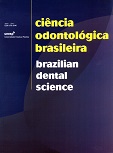Skeletal maturation of cervical vertebrae and hand-wrist region
DOI:
https://doi.org/10.14295/bds.2011.v14i1/2.698Keywords:
Cervical Vertebrae. Osteogenesis. Growth and development.Abstract
The evaluation of the bone maturation is very important for the orthodontic diagnostic and treatment plan and many places of the body can be utilized for this goal. The aim of this study was to verify the correlation between hand-wrist and cervical maturation stages of skeletal maturation. Lateral cephalometrics and hand wrist radiographs were made. The Hassel and Farm method was used for the cervical vertebras and Singer simplified method for the hand wrist radiographs. About 60 patients formed the sample with ages ranging between 7 and 14 years. From this total, 30 were male and 30 female. Spearman’s (r1) and Kendall’s (r2) coefficients were used to establish the correlation among the 6 stages presented by the two methods. The male group’s results were r1= 0.680 and r2= 0.656, the female group’s were r1= 0.666 and r2= 0.634 and the whole sample’s were r1= 0.743 and r2= 0.696. All the results showed a high correlation, statistically significant (p≤ 0.001). There was a significant correlation among maturation stages presented by both methods. The radiograph evaluation of the cervical vertebras is an alternative parameter which is practical and completes the range of information that can be obtained from cephalometric radiographs and it can, circumstantially, replace other method for evaluation, further on decreasing the additional x-ray exposition.
Downloads
Downloads
Additional Files
Published
How to Cite
Issue
Section
License
Brazilian Dental Science uses the Creative Commons (CC-BY 4.0) license, thus preserving the integrity of articles in an open access environment. The journal allows the author to retain publishing rights without restrictions.
=================




























